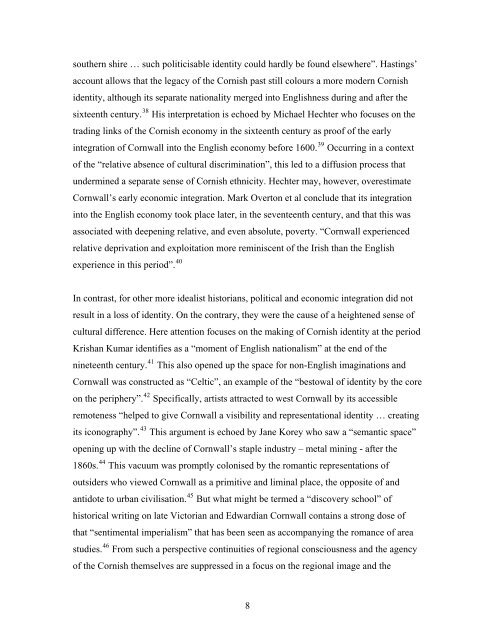Britishness, what it is and what it could be, is now high on both ...
Britishness, what it is and what it could be, is now high on both ...
Britishness, what it is and what it could be, is now high on both ...
Create successful ePaper yourself
Turn your PDF publications into a flip-book with our unique Google optimized e-Paper software.
southern shire … such pol<str<strong>on</strong>g>it</str<strong>on</strong>g>ic<str<strong>on</strong>g>is</str<strong>on</strong>g>able ident<str<strong>on</strong>g>it</str<strong>on</strong>g>y <str<strong>on</strong>g>could</str<strong>on</strong>g> hardly <str<strong>on</strong>g>be</str<strong>on</strong>g> found elsewhere”. Hastings’<br />
account allows that the legacy of the Corn<str<strong>on</strong>g>is</str<strong>on</strong>g>h past still colours a more modern Corn<str<strong>on</strong>g>is</str<strong>on</strong>g>h<br />
ident<str<strong>on</strong>g>it</str<strong>on</strong>g>y, although <str<strong>on</strong>g>it</str<strong>on</strong>g>s separate nati<strong>on</strong>al<str<strong>on</strong>g>it</str<strong>on</strong>g>y merged into Engl<str<strong>on</strong>g>is</str<strong>on</strong>g>hness during <str<strong>on</strong>g>and</str<strong>on</strong>g> after the<br />
sixteenth century. 38 H<str<strong>on</strong>g>is</str<strong>on</strong>g> interpretati<strong>on</strong> <str<strong>on</strong>g>is</str<strong>on</strong>g> echoed by Michael Hechter who focuses <strong>on</strong> the<br />
trading links of the Corn<str<strong>on</strong>g>is</str<strong>on</strong>g>h ec<strong>on</strong>omy in the sixteenth century as proof of the early<br />
integrati<strong>on</strong> of Cornwall into the Engl<str<strong>on</strong>g>is</str<strong>on</strong>g>h ec<strong>on</strong>omy <str<strong>on</strong>g>be</str<strong>on</strong>g>fore 1600. 39 Occurring in a c<strong>on</strong>text<br />
of the “relative absence of cultural d<str<strong>on</strong>g>is</str<strong>on</strong>g>criminati<strong>on</strong>”, th<str<strong>on</strong>g>is</str<strong>on</strong>g> led to a diffusi<strong>on</strong> process that<br />
undermined a separate sense of Corn<str<strong>on</strong>g>is</str<strong>on</strong>g>h ethnic<str<strong>on</strong>g>it</str<strong>on</strong>g>y. Hechter may, however, overestimate<br />
Cornwall’s early ec<strong>on</strong>omic integrati<strong>on</strong>. Mark Overt<strong>on</strong> et al c<strong>on</strong>clude that <str<strong>on</strong>g>it</str<strong>on</strong>g>s integrati<strong>on</strong><br />
into the Engl<str<strong>on</strong>g>is</str<strong>on</strong>g>h ec<strong>on</strong>omy took place later, in the seventeenth century, <str<strong>on</strong>g>and</str<strong>on</strong>g> that th<str<strong>on</strong>g>is</str<strong>on</strong>g> was<br />
associated w<str<strong>on</strong>g>it</str<strong>on</strong>g>h deepening relative, <str<strong>on</strong>g>and</str<strong>on</strong>g> even absolute, poverty. “Cornwall experienced<br />
relative deprivati<strong>on</strong> <str<strong>on</strong>g>and</str<strong>on</strong>g> explo<str<strong>on</strong>g>it</str<strong>on</strong>g>ati<strong>on</strong> more remin<str<strong>on</strong>g>is</str<strong>on</strong>g>cent of the Ir<str<strong>on</strong>g>is</str<strong>on</strong>g>h than the Engl<str<strong>on</strong>g>is</str<strong>on</strong>g>h<br />
experience in th<str<strong>on</strong>g>is</str<strong>on</strong>g> period”. 40<br />
In c<strong>on</strong>trast, for other more ideal<str<strong>on</strong>g>is</str<strong>on</strong>g>t h<str<strong>on</strong>g>is</str<strong>on</strong>g>torians, pol<str<strong>on</strong>g>it</str<strong>on</strong>g>ical <str<strong>on</strong>g>and</str<strong>on</strong>g> ec<strong>on</strong>omic integrati<strong>on</strong> did not<br />
result in a loss of ident<str<strong>on</strong>g>it</str<strong>on</strong>g>y. On the c<strong>on</strong>trary, they were the cause of a heightened sense of<br />
cultural difference. Here attenti<strong>on</strong> focuses <strong>on</strong> the making of Corn<str<strong>on</strong>g>is</str<strong>on</strong>g>h ident<str<strong>on</strong>g>it</str<strong>on</strong>g>y at the period<br />
Kr<str<strong>on</strong>g>is</str<strong>on</strong>g>han Kumar identifies as a “moment of Engl<str<strong>on</strong>g>is</str<strong>on</strong>g>h nati<strong>on</strong>al<str<strong>on</strong>g>is</str<strong>on</strong>g>m” at the end of the<br />
nineteenth century. 41 Th<str<strong>on</strong>g>is</str<strong>on</strong>g> also opened up the space for n<strong>on</strong>-Engl<str<strong>on</strong>g>is</str<strong>on</strong>g>h imaginati<strong>on</strong>s <str<strong>on</strong>g>and</str<strong>on</strong>g><br />
Cornwall was c<strong>on</strong>structed as “Celtic”, an example of the “<str<strong>on</strong>g>be</str<strong>on</strong>g>stowal of ident<str<strong>on</strong>g>it</str<strong>on</strong>g>y by the core<br />
<strong>on</strong> the periphery”. 42 Specifically, art<str<strong>on</strong>g>is</str<strong>on</strong>g>ts attracted to west Cornwall by <str<strong>on</strong>g>it</str<strong>on</strong>g>s accessible<br />
remoteness “helped to give Cornwall a v<str<strong>on</strong>g>is</str<strong>on</strong>g>ibil<str<strong>on</strong>g>it</str<strong>on</strong>g>y <str<strong>on</strong>g>and</str<strong>on</strong>g> representati<strong>on</strong>al ident<str<strong>on</strong>g>it</str<strong>on</strong>g>y … creating<br />
<str<strong>on</strong>g>it</str<strong>on</strong>g>s ic<strong>on</strong>ography”. 43 Th<str<strong>on</strong>g>is</str<strong>on</strong>g> argument <str<strong>on</strong>g>is</str<strong>on</strong>g> echoed by Jane Korey who saw a “semantic space”<br />
opening up w<str<strong>on</strong>g>it</str<strong>on</strong>g>h the decline of Cornwall’s staple industry – metal mining - after the<br />
1860s. 44 Th<str<strong>on</strong>g>is</str<strong>on</strong>g> vacuum was promptly col<strong>on</strong><str<strong>on</strong>g>is</str<strong>on</strong>g>ed by the romantic representati<strong>on</strong>s of<br />
outsiders who viewed Cornwall as a prim<str<strong>on</strong>g>it</str<strong>on</strong>g>ive <str<strong>on</strong>g>and</str<strong>on</strong>g> liminal place, the oppos<str<strong>on</strong>g>it</str<strong>on</strong>g>e of <str<strong>on</strong>g>and</str<strong>on</strong>g><br />
antidote to urban civil<str<strong>on</strong>g>is</str<strong>on</strong>g>ati<strong>on</strong>. 45 But <str<strong>on</strong>g>what</str<strong>on</strong>g> might <str<strong>on</strong>g>be</str<strong>on</strong>g> termed a “d<str<strong>on</strong>g>is</str<strong>on</strong>g>covery school” of<br />
h<str<strong>on</strong>g>is</str<strong>on</strong>g>torical wr<str<strong>on</strong>g>it</str<strong>on</strong>g>ing <strong>on</strong> late Victorian <str<strong>on</strong>g>and</str<strong>on</strong>g> Edwardian Cornwall c<strong>on</strong>tains a str<strong>on</strong>g dose of<br />
that “sentimental imperial<str<strong>on</strong>g>is</str<strong>on</strong>g>m” that has <str<strong>on</strong>g>be</str<strong>on</strong>g>en seen as accompanying the romance of area<br />
studies. 46 From such a perspective c<strong>on</strong>tinu<str<strong>on</strong>g>it</str<strong>on</strong>g>ies of regi<strong>on</strong>al c<strong>on</strong>sciousness <str<strong>on</strong>g>and</str<strong>on</strong>g> the agency<br />
of the Corn<str<strong>on</strong>g>is</str<strong>on</strong>g>h themselves are suppressed in a focus <strong>on</strong> the regi<strong>on</strong>al image <str<strong>on</strong>g>and</str<strong>on</strong>g> the<br />
8
















